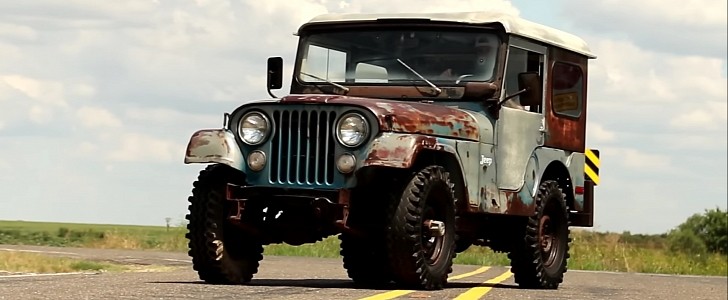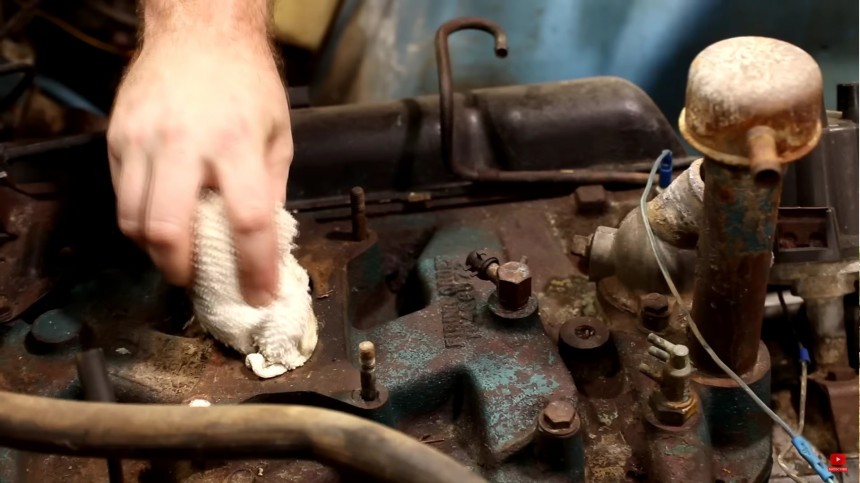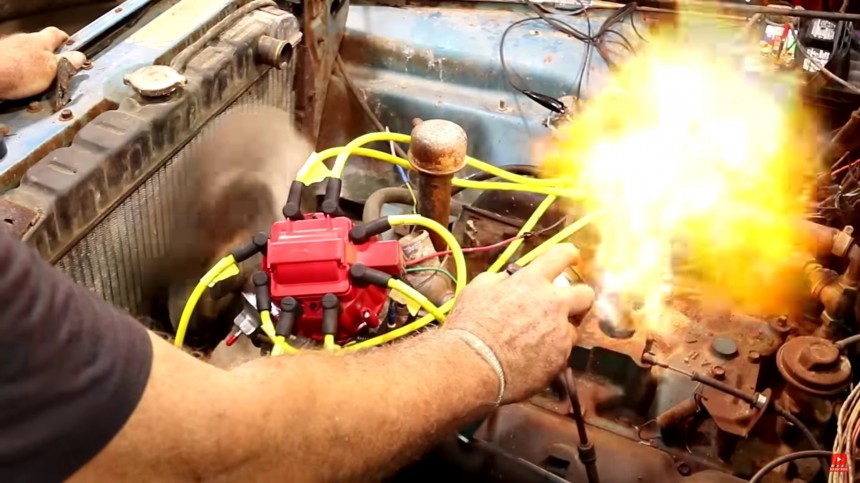The legendary car is the star of this excellent silent salvage visual tutorial from the widely popular "Restored" YouTubers. Contrary to their boisterous style of video restoring, this film is a masterpiece of pure filmic excellence: no talk, no noise, just mechanics doing their job.
The car is in perfect salvage patina, with rusty livery, flat rear tire, and otherwise integral structure. The engine – a V8, for that matter! – is soaking in rust and dust. But it is an excellent engine on a great car, and its resilience is unparalleled. The CJ-5 held – and still does! – the extraordinary quality of being a hard-to-kill vehicle.
The production for the fifth iteration of the tough-as-nails small Civilian Jeep ran for three decades, from 1954 to 1983, totaling a little over 603,000 examples. Excellent numbers for an automobile from a very agricultural, farm-destined ancestry.
That's right; this tiny humble-looking utilitarian vehicle was the forerunner of SUVs. In the mid-40s, the first CJ-5 was a multi-tool for rural usage (take a look at the photo gallery for details). Capable of handling everything the driver threw at it, the CJ models gradually skidded from utilitarian to sporty by the time the car in our story came around.
The survivor we see here has the AMC 304 ci (5.0 liter) V8, which first equipped the 1972 models. Since we popped up the hood, let's see what was needed to bring the mighty American Motors Corporation power plant to life. Please note that AMC bought the Jeep brand in 1970, and changes immediately followed.
It takes surprisingly little work to resurrect the great V8. A new battery, a new fuel pump, an electronic distributor instead of the old breaker point, new spark plugs, and a good fuel tank sending unit cleaning. The silent duo installed an extra filter to ensure a clean gas feed to the single-barrel carburetor. Also, a new ignition cylinder lock replaced the original one.
The engine looks rusty, but it packs a hefty punch – it fires up well, as we can see in the video. A compression test revealed the pistons' good working condition, and a prestart oiling only made the first fire-up in 25 years even smoother.
The beautiful engine did not give up on life, and, with minor adjustments, it ran as if it had just come off the assembly line. The car gets proper cosmetic treatment to emphasize this fulfilling achievement. An excellent deep exterior wash eliminates debris and prepares the bodywork for the spoils of a linseed oil coating.
Overall, the field-abandoned little Jeep rewarded its saviors with excellent and successful restoration work. Despite being flat, the left rear tire immediately sprung back into action, and it held up to the first drive and even more. Check the video to see what's what about the V8-powered 1973 CJ-5 Jeep.
Since it was the most extensively worked-on part of the car, let's have a good look at the engine. As mentioned before, it is a V8 – easily distinguishable from its slanted cylinder heads and the eight spark plug wires on the distributor. Also, the wire-brushing of the cast-in firing sequence reveals the engine's identity.
The 302 ci (5.0 liters) from AMC, with an actual output of 150 hp (112 kW, or 152 PS) net power, was quite a surprise from a car with a curb weight of just 2,665 lb. (1,209 kg). The power-to-weight ratio would put it eyebrow-raising close to muscle cars of the same era (remember the power limitations due to the emission control regulations).
Three-speed or four-speed manual transmissions were available for the CJ-5, coupled with low- and hi-range transfer case. To fit the engine in the CJ-5, AMC extended the wheelbase from 81 in (2,057 mm) – unchanged from 1954 to 1971 – to 83.5 in (2,121 mm). Its "sardine tin on wheels" aspect ratio was primarily preserved, with the width of 68.5 in (1,740 mm) being almost equal to the height – of 67.7 in (1,720 mm).
Its rugged linear design strengthened the square front look, with the tapering nose and flared fenders paying respect to the war icon Jeep Willys. With an overall length of 138.2 in (3,510 mm), the rectangular-looking hardtop Jeep only augmented the brand's rough, out-of-road going image.
To further amplify the sportiness tendency of the CJ family, AMC removed the PTO fittings from the CJ-5 and the following models. No longer appealing to farmers and the likes, the CJ gained growing popularity with a new, young, adventurous generation that would cement the Jeep's daring, frontier-breaking epitome.
The production for the fifth iteration of the tough-as-nails small Civilian Jeep ran for three decades, from 1954 to 1983, totaling a little over 603,000 examples. Excellent numbers for an automobile from a very agricultural, farm-destined ancestry.
That's right; this tiny humble-looking utilitarian vehicle was the forerunner of SUVs. In the mid-40s, the first CJ-5 was a multi-tool for rural usage (take a look at the photo gallery for details). Capable of handling everything the driver threw at it, the CJ models gradually skidded from utilitarian to sporty by the time the car in our story came around.
The survivor we see here has the AMC 304 ci (5.0 liter) V8, which first equipped the 1972 models. Since we popped up the hood, let's see what was needed to bring the mighty American Motors Corporation power plant to life. Please note that AMC bought the Jeep brand in 1970, and changes immediately followed.
The engine looks rusty, but it packs a hefty punch – it fires up well, as we can see in the video. A compression test revealed the pistons' good working condition, and a prestart oiling only made the first fire-up in 25 years even smoother.
The beautiful engine did not give up on life, and, with minor adjustments, it ran as if it had just come off the assembly line. The car gets proper cosmetic treatment to emphasize this fulfilling achievement. An excellent deep exterior wash eliminates debris and prepares the bodywork for the spoils of a linseed oil coating.
Overall, the field-abandoned little Jeep rewarded its saviors with excellent and successful restoration work. Despite being flat, the left rear tire immediately sprung back into action, and it held up to the first drive and even more. Check the video to see what's what about the V8-powered 1973 CJ-5 Jeep.
The 302 ci (5.0 liters) from AMC, with an actual output of 150 hp (112 kW, or 152 PS) net power, was quite a surprise from a car with a curb weight of just 2,665 lb. (1,209 kg). The power-to-weight ratio would put it eyebrow-raising close to muscle cars of the same era (remember the power limitations due to the emission control regulations).
Three-speed or four-speed manual transmissions were available for the CJ-5, coupled with low- and hi-range transfer case. To fit the engine in the CJ-5, AMC extended the wheelbase from 81 in (2,057 mm) – unchanged from 1954 to 1971 – to 83.5 in (2,121 mm). Its "sardine tin on wheels" aspect ratio was primarily preserved, with the width of 68.5 in (1,740 mm) being almost equal to the height – of 67.7 in (1,720 mm).
Its rugged linear design strengthened the square front look, with the tapering nose and flared fenders paying respect to the war icon Jeep Willys. With an overall length of 138.2 in (3,510 mm), the rectangular-looking hardtop Jeep only augmented the brand's rough, out-of-road going image.
To further amplify the sportiness tendency of the CJ family, AMC removed the PTO fittings from the CJ-5 and the following models. No longer appealing to farmers and the likes, the CJ gained growing popularity with a new, young, adventurous generation that would cement the Jeep's daring, frontier-breaking epitome.






















































